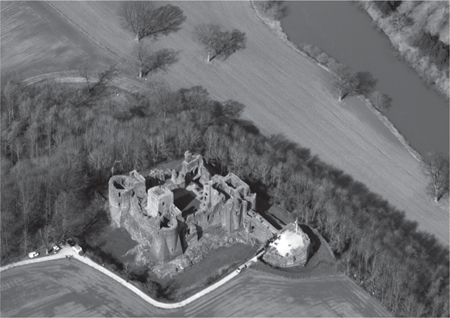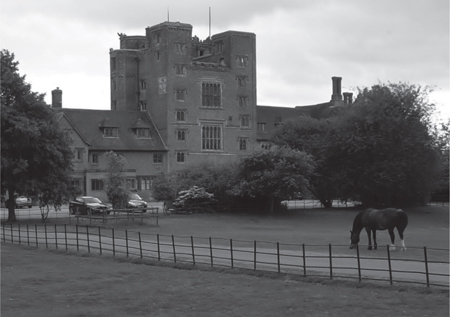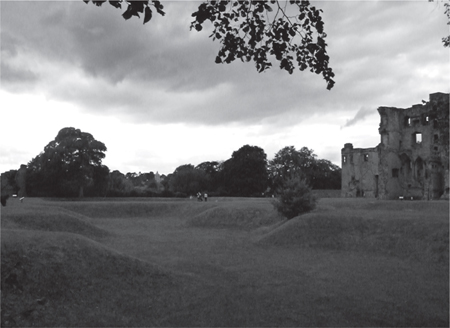The Medieval English Landscape, 1000-1540 (40 page)
Read The Medieval English Landscape, 1000-1540 Online
Authors: Graeme J. White

The thirteenth century, when rising population inflated the incomes to be derived from landed estates, is generally reckoned to be the time when castle architecture reached its apogee in England – whether this is interpreted in terms of military defensibility or of conspicuous grandeur and display. As we have seen, the underlying design principle in this century was to strengthen the defensive ring, but in the greatest castles this involved more than merely placing towers along the curtain walls. On the one hand, gatehouses were not only enhanced through the provision of several barriers within the entrance passage itself but they were also provided with barbicans (fortified approaches) for added protection. On the other, the inner wards or baileys of some castles were completely surrounded by secondary outer baileys, to create so-called ‘concentric castles’. The late-thirteenth-century Edwardian castles of North Wales are usually cited in this context, but there are plenty of examples in England. We have already seen that Henry II’s stone
donjon
at Dover Castle was soon surrounded by a double line of walled defences. When Beeston was built for the Earl of Chester in the 1220s, an outer curtain wall with open-backed D-shaped towers – less substantial than those of the inner curtain – was constructed so as to create an outer bailey on the more vulnerable south-eastern slope from which the castle would normally be approached. Helmsley Castle was provided with barbicans outside its north and south gates during the course of the thirteenth century, allowing visitors to be contained before admission, with that on the south side being remodelled in the first half of the fourteenth to incorporate further domestic accommodation. And at Goodrich (Herefordshire), either side of 1300, a castle which in the twelfth century had been dominated by a square great tower underwent major rebuilding for Henry III’s half-brother William de Valence and his son Aymer. The result was an inner ward housing domestic ranges, with round towers at three of its corners and a round-towered gatehouse at the fourth; added defence was provided by an outer curtain wall and barbican on two sides and a massive rock-hewn ditch elsewhere (
Figure 35
). To enhance the security of this outer ring, the gatehouse – which served as a residential block with chapel and well-appointed living rooms but was potentially the most vulnerable part of the defensive circuit – was furnished with a drawbridge, two portcullises, heavy wooden doors and ‘murder-holes’ in the vault above the entrance passage.
47

Figure 35: Goodrich Castle (Herefordshire)
. Goodrich Castle was intended to command the Wye valley, both militarily and as a building to be admired. With its twelfth-century square keep, thirteenth-century round corner towers and large fourteenth-century D-shaped barbican, overlooking and protecting fine domestic accommodation, it is an excellent illustration of developments in medieval military architecture. (English Heritage Photo Library.)
Goodrich still presents a spectacular image to those travelling along the River Wye, and in assessing any castle of the thirteenth and early fourteenth centuries it is impossible to ignore a concern for grandiose display. Beeston,
for example, sits on a rocky crag from which eight counties can be seen and has different coloured masonry banded across its main entrance in a manner reminiscent of Henry II’s keep at Dover and Henry III’s curtain walls at Windsor; it gives every appearance of having been intended to signal the partly independent authority enjoyed by the Earl of Chester. Helmsley’s early fourteenth-century gate passage in its southern barbican was provided with decorative stonework which had no military purpose and can only have been intended to impress legitimate visitors. By then there was already a ‘processional route’ at Helmsley, whereby visitors approaching from the ford over the nearby River Rye were guided not direct through the south gate but all the way round the castle so that its features could be admired before they were admitted.
48
The access to Goodrich via the barbican achieves a similar effect. Yet while these castles were certainly status symbols, designed to impress from an aesthetic point of view, they were also formidable structures in purely military terms. Their occupants must have taken considerable comfort from that.
The story from hereon has usually been written as one of castle ‘decline’, as the economic realities of the late middle ages took their toll. As we have seen, brick – usually locally available and much cheaper than stone – was introduced as the principal building material in a number of new castles of the fifteenth century. In place of several towers reliance came to be placed once again on one: sometimes a ‘great tower’ as at Warkworth or Ashby-dela-Zouch, sometimes the gatehouse, where the main access to the castle was enhanced to become not only a residential block but also the grandest feature of the entire complex. Tattershall Castle is often cited as typical of the period, with its great tower in brick, built in the 1430s and 1440s and replete with decorative features, overseeing an adjoining hall: these two adjacent buildings replaced a thirteenth-century stone castle presumed to have had curtain walls and corner towers.
Seen strictly as fortifications, most of these late-medieval castles were unimpressive. If there was any military case for preferring cylindrical or D-shaped towers in the thirteenth century (itself open to debate) there was none for reverting to rectangular ones in the fifteenth – and we have already seen that those at Tattershall (in brick) and Ashby-de-la-Zouch (stone) had fundamental weaknesses in their defensibility. At Kirby Muxloe, four masons were specially employed to create ‘pictures in the walls’ using dark bricks – hence the diaper patterns still visible today – but the openings from which to fire cannon were placed below the waterline of the moat and had to be blocked in. Much of the machicolation below the battlements of castles of this period was too narrow to have been of any practical use; anything dropped from that at Caesar’s Tower, Warwick, built in the 1360s, would have hit its own massively splayed base. All this lends credence to the view that from the early fourteenth century onwards, most castles were essentially for ‘display’, using the motifs of militarism – gun ports and machicolation among them – as decoration rather than for any serious offensive or defensive purpose. After all, the same architectural details – great gatehouse, battlements, traces of machicolation – can be found in late fifteenth-century buildings which are not usually considered to be ‘castles’, such as the Bedingfield family’s Oxburgh Hall (Norfolk) for which a ‘licence to crenellate’ was issued in 1482, and the Bishop of Lincoln’s Buckden Palace (Huntingdonshire). And already, from the late fourteenth century onwards, some members of the nobility were choosing to build sumptuous courtyard-houses – which had a hall range opposite the gatehouse and accommodation wings ranged along the other two sides – without even a nod to defensibility, in preference to more traditional military-looking structures: Dartington Hall (Devon) of the 1380s
and 1390s for the future Duke of Exeter, South Wingfield (Derbyshire) of the 1440s for Lord Treasurer Cromwell and Knole (Kent) of the 1450s to 1480s for the Archbishop of Canterbury are cases in point. Layer Marney Tower, built in the early 1520s for one of Henry VIII’s leading councillors, would have been another example had the family not died out when only one side of the courtyard had been built; as it is, we are left with a decorative brick-built gatehouse taller than any of its Tudor predecessors, boasting four corner turrets but with no battlements in sight. Nothing could send the message more clearly that for the late-medieval nobility, priorities in domestic accommodation had changed (
Figure 36
).

Figure 36: Layer Marney Tower (Essex)
. The tall brick gatehouse of the early 1520s had no military function but was intended as an impressive entrance to the courtyard of a palatial country house. This was never built, so the area is now used by livestock and cars, which approach the feature from the ‘wrong’ side.
But how far should the story of castles in the fourteenth and fifteenth centuries really be told as one of ‘decline’? Okehampton Castle, for example, originally a motte-and-bailey for William the Conqueror’s sheriff of Devon, was extensively rebuilt in the first half of the fourteenth century with barbican, gatehouse, hall, lodgings, kitchens, and a residential extension to the Norman great tower: but there was an obvious weakness in the defensibility of all this, since in many places the new domestic buildings reached a height above that of the surrounding curtain wall. As the English Heritage Guidebook puts it, ‘the role of Okehampton Castle had shifted from that of secure military stronghold … towards a country retreat, where the family could enjoy hunting and … impress guests with their wealth’; the adjoining deer park was developed accordingly.
50
Elsewhere, Bodiam Castle (Sussex), which dates to the 1380s, has a broad water-filled moat and an elaborate gatehouse, but can be criticized from a military standpoint on any number of counts: among them the ease with which the bank retaining the moat could be breached, the impracticality of its arrow loops and gun ports, and the modest size of the battlements so that a man standing upright would not be fully protected. Bodiam is in reality a small-scale castle, with round corner towers which would be dwarfed by those in North Wales, made to look bigger by its reflection in the moat. Yet close analysis of its landscape context shows the care which was taken to reveal the structure in stages to an approaching guest, whose route would be controlled by a causeway and who would encounter the moat, the chapel, the symmetrical north front, the gatehouse and the inner courtyard as a series of progressive disclosures. Much the same could be said of the less well-known castle at Cooling (Kent), also of the 1380s, where high ground to the north overlooks the outer ramparts, and the rounded curtain towers have no backs, but where a visitor would be guided through to behold the reflections in the broad moat of one apparently round tower after another, as well as the latest fashion in gun ports.
51
All this could be dismissed as a ‘sham’, yet these castles are a visual delight, offering enjoyment to the visitor and gratification to the owner. The proliferation of formal gardens within castles can be seen in the same light. One of the first tasks undertaken at Kirby Muxloe in 1480, before any buildings were put up, was to clear woodland so a garden could be planted; the elaborate sunken depressions to be seen at both Stafford and Ashby-de-la-Zouch can also safely be interpreted as late-medieval garden features, from which excellent views could be enjoyed from the great towers nearby (
Figure 37
).
52
In terms of what was intended, all this is a long way from ‘decline’.

Figure 37: Ashby de la Zouch Castle (Leicestershire)
. The great tower of the 1470s, to right, overlooked elaborate sunken gardens, which were part of a wider ornamental landscape including a deer park. The small brick tower on the extreme left is one of three (probably added in the 1530s) from which these features could be admired.
